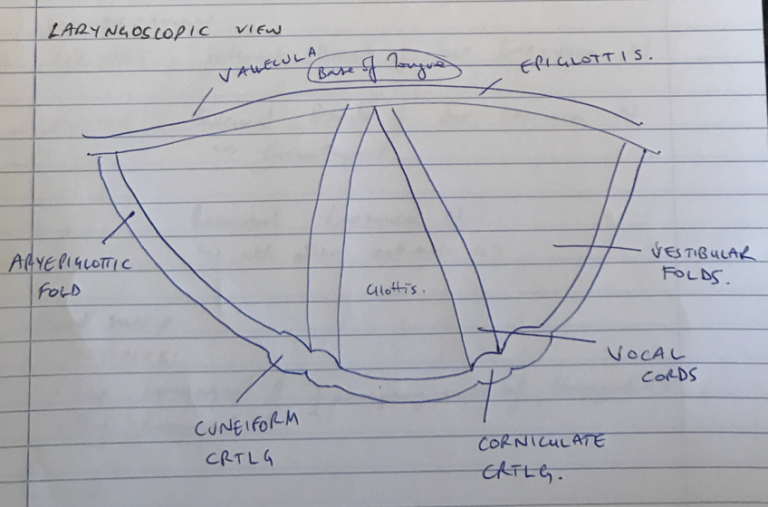Xvi / 23B16 / 20B14 / 15A24: Anatomy of the larynx
23B16: Exam Report
Outline the anatomy of the larynx
44% of candidates passed this question.
This question required candidates to address the following relevant to the anatomy of the larynx – it’s location and extent; relations; structure (paired and unpaired cartilages; major ligaments; intrinsic and extrinsic muscles); nerve supply (sensory and motor); and blood supply (and venous darinage).
There were some marks allocated for other correct information relevant to the anatomy of the larynx (e.g. epithelium; differences in age; lymphatic drainage).
This was a purely anatomy question so functions of the larynx was not required.
20B14: Exam Report
Describe the anatomy of the larynx
40% of candidates passed this question.
For this question, candidates were expected to address the location of the larynx, its relations, the cartilages (single and paired), ligaments, muscles (intrinsic and extrinsic), innervation (sensory and muscular) and blood supply (including venous drainage). Marks were apportioned to each section, so whilst some detail was required, breadth of knowledge was also important. Most candidates had a grasp of the gross anatomy, the main relations and at least the innervation provided by the recurrent laryngeal nerve. However, an understanding of the functional anatomy of the cartilages was not always apparent. It should be noted that not every single muscle needed to be named (especially for the extrinsic muscles), but an understanding of the major muscle groups should have been included.
15A24: Exam Report
Outline the anatomy of the larynx.
25% of candidates passed this question.
It was expected that an answer would include the names of the three single and three paired laryngeal cartilages, intrinsic and extrinsic muscles (names were not required), nerve supply (motor and sensory) and blood supply. Many candidates had good illustrations though a drawing was not essential.
The majority of candidates failed to name the laryngeal cartilages. There was much confusion about whether certain structures were bones or cartilage or even muscle. The relation of the larynx to the thyroid gland was frequently misunderstood.
Many answers focussed on the relations of the larynx but omitted basic information about the larynx itself. No marks were awarded for the contents of the carotid sheath or the course of the recurrent laryngeal nerve both of which were frequently included in answers.
Xvi / 23B16 / 20B14 / 15A24: Anatomy of the larynx
Definition: An airway cavity connecting hypopharynx → trachea
- From epiglottis → cricoid cartilage
- 9 cartilages; 3 single & 3 paired
- SINGLE:
- Epiglottis
- Anchored to base of tongue
- Free sup. flap opens/closes entry to larynx
- Thyroid cartilage
- Largest
- Cricoid cartilage
- Signet ring
- Forms posterior wall of larynx
- Most inferior cartilage
- PAIRED
- Arytenoid cartilages
- Attach cricoarytenoid m.
- Most important → influence position & tension of vocal folds
- Corniculate cartilages
- Cuneiform cartilages
Airway Cavity
- 2 pairs of mucous membrane foldings
- Upper folds → VESTIBULAR FOLDS
- Minimal phonation role, protects delicate folds below
- Lower folds → TRUE VOCAL CORDS
- Narrowest part of the larynx
- Forms slit-like opening of the glottis
- White = avascular
Above VC (mucous membrane foldings) = STRATIFIED SQUARE EPITHELIUM because may be subject to food contact.
Below VC = PSEUDO-STRATIFIED CILIARY COLUMNAR → mucociliary
- Therefore always projecting mucous up & away from lungs
Laryngeal Muscles
Intrinsic Muscles
→ Length, shape, tension of vocal folds
- Adductors
- Lateral cricoarytenoid m.
- Thyroarytenoid m.
- Interarytenoid m.
- Abductor: Posterior cricoarytenoid m.
- Tensor muscle: Cricothyroid m.
Extrinsic Muscles
→ Laryngeal stabilisation
- Infrahyoid strap muscles

Innervation
- Sensory: internal branch of sup. laryngeal n.
- Motor: External branch of sup. laryngeal n. → cricothyroid
Recurrent laryngeal n. → all other intrinsic m.
Blood Supply
- Arteries (accompanies nerves)
- Superior laryngeal a.
- Inferior laryngeal a.
- Veins
- Superior & inferior thyroid v.
Larynx Function
- Remove foreign particles, warm & humidify air
- Ciliated mucous lining of larynx
- Swallowing
- Larynx is raised & covered to prevent entry
- Cough reflex
- Stimulation of vocal folds & laryngeal muscles to expel entry of foreign bodies & prevent choking
- Phonation
- Expired air from lungs passes through VC
- Movement of intrinsic muscles (length + tension) allows range of sound + pitch
- Breathing
- Passageway connecting lungs to pharynx